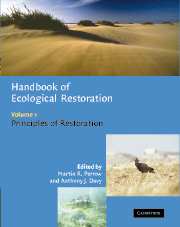Book contents
- Frontmatter
- Contents
- List of contributors
- Foreword
- Preface
- Part 1 The background
- Part 2 Manipulation of the physical environment
- 6 Terrestrial systems
- 7 Wetlands and still waters
- 8 Running water: fluvial geomorphology and river restoration
- Part 3 Manipulation of the chemical environment
- Part 4 Manipulation of the biota
- Part 5 Monitoring and appraisal
- Index
- References
7 - Wetlands and still waters
Published online by Cambridge University Press: 29 December 2009
- Frontmatter
- Contents
- List of contributors
- Foreword
- Preface
- Part 1 The background
- Part 2 Manipulation of the physical environment
- 6 Terrestrial systems
- 7 Wetlands and still waters
- 8 Running water: fluvial geomorphology and river restoration
- Part 3 Manipulation of the chemical environment
- Part 4 Manipulation of the biota
- Part 5 Monitoring and appraisal
- Index
- References
Summary
INTRODUCTION
Wetland and still water habitats are elements of a continuum that depend upon water storage and supply for their continued existence and ecological stability. If inputs of water are significantly reduced, or outputs are increased, the water balance will change and wetland ecology is likely to suffer. Many types of wetland have frequently been damaged by artificial drainage, in what has been termed ‘reclamation’ for economic exploitation such as agriculture, forestry or peat production (see, for example, Gilman, 1994). Also significant in many situations may be a change in water-storage capacity, either by manipulation of the ground surface (peat extraction) or by increased sedimentation caused by accelerated soil erosion as a result of human land-use changes. Cooke et al. (1993) indicated that 25% of lakes assessed in the USA could be described as ‘impaired’ and 20% as ‘threatened’ in some way. Often this was by nutrient enrichment, but other stresses included siltation and inappropriate water levels.
Allen & Feddema (1996) suggest that wetland restoration involves actions aimed at improving damaged or deteriorating areas that were once healthy wetlands. In many countries, these natural wetlands are now only a fraction of their historical extent and have been identified as priority habitats for ecological restoration (e.g. Cooke et al., 1993; Allen & Feddema, 1996; Tallis, 1998).
This chapter relates to the fundamental principles that control the physical environment of wetlands and still waters. It concentrates upon fresh waters rather than estuarine or coastal wetlands.
- Type
- Chapter
- Information
- Handbook of Ecological Restoration , pp. 106 - 132Publisher: Cambridge University PressPrint publication year: 2002
References
- 4
- Cited by



